 Rebekah Wing
Rebekah Wing Nhi Py
Nhi Py Martine Falk Andersen
Martine Falk Andersen Robbie W
Robbie W Mikko Puttonen
Mikko Puttonen
David and Victoria Beckham's son Romeo is to design his own range of sunglasses. Romeo, eight, has reportedly signed a deal to create a line of children's shades after begging his parents to let him become a fashion designer. A friend of the family told the Daily Mirror newspaper: "Romeo has a real eye for fashion. "He has strong opinions on what works and what doesn't, and has been badgering David and Victoria for months about designing his own sunglasses. It is no passing whim - Victoria said she'd only back the project if he was certain he wanted to do it." It is believed that well connected Romeo will call on his young celebrity pals - including Tom Cruise's daughter Suri Cruise, Leni, the six-year-old daughter of supermodel Heidi Klum, and TV chef Gordon Ramsay's four children - to model the frames. Singer-turned-fashion designer Victoria and soccer star David - who have two other sons, Brooklyn, 11 and five-year-old Cruz - are both thrilled with Romeo's entrepreneurial spirit and ambition. The pal said: "There is a gap in the market for designer kids' shades that are 100 per cent UV protected and trendy. "The glasses are made especially for children and will have a cool 'RB' motif on one arm. The range was originally going to be called Bambino Beckham. Both Victoria and David are delighted."
Models present creations from the Vivienne Westwood 2011 Spring/Summer collection at London Fashion Week September 19, 2010.
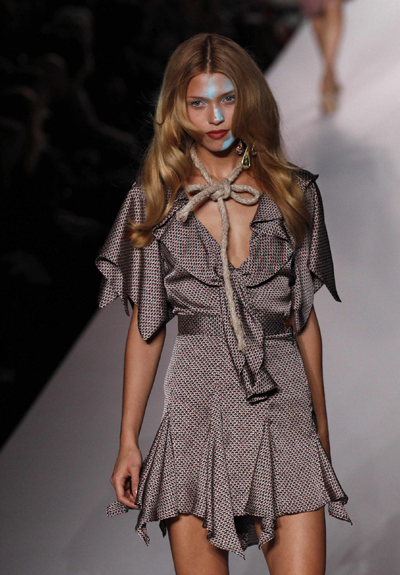
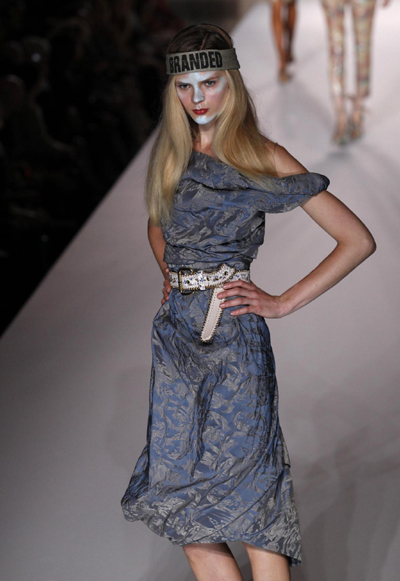
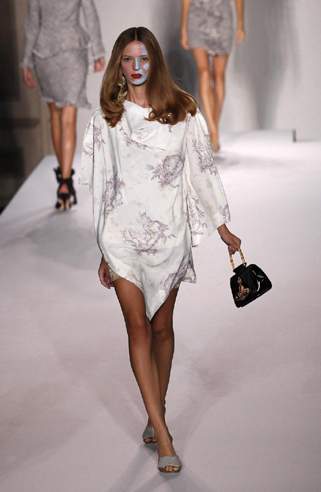
Leather handbags and high heeled shoes will continue to gain room in women's wardrobes as luxury groups plan to increase their offer to spice up sales, Italian fashion houses said at Milan's shows this week.
Sales of high-end accessories, which are easier to wear and offer higher sales margins than clothes, have boomed during the downturn, helping fashion houses offset the falling demand for more costly luxury goods.
Fashion names such as Roberto Cavalli and Versace have said they aim to boost production of handbags and shoes next year.
"Accessories are the entry point to the world of luxury fashion for many people, and they have performed this role for many years," Versace's Chief Executive Gian Giacomo Ferraris told Reuters in an emailed interview.
"It stands to reason that during an economic crisis they would do better than other sectors of the market, and I am confident that they will continue to perform well in the future."
Ferraris, who is repositioning Versace's brand after the company was hit hard by the downturn, has said he expects retail sales to rise around 9 percent to 130 million euros ($173.5 million) in 2010.
Italian fashion house Cavalli, best known for its animal print clothes, has said it aims to increase its handbags and shoes businesses in the next two to three years, after retail sales grew double-digit in the first quarter.
"Versace is no exception here - we benefit from our great accessories product range and our know-how in this crucial area," Ferraris said.
METALLIC HEELS AT GUCCI, THICK SOLES AT PRADA
At their spring-summer 2011 womenswear shows this week, Prada presented the thick-soled multicolor sneakers seen at the men's show in June, while D&G bet on wedge shoes.
"People will buy more high heeled shoes. Shoes are an integral part of wardrobes," trend-setter Elio Fiorucci, founder of the namesake fashion brand, told Reuters at Gucci's show.
Gucci's designer Frida Giannini chose mini shoulder bags and booties with python details and metallic heels for her sensual collection, which also featured oversized gold bracelets.
"There is a huge demand for accessories. We will see a growing interest in hats, necklaces and big bracelets," Italian designer Paola Frani told Reuters after her show, where minimalist and clean-cut dresses were twinned with belts in light gold and floral necklaces.
The Milan fashion week runs until September 28, with Armani showing at the end in an effort to balance the longer calendar.
Models present creations of designer Hannibal Laguna during a fashion show in Madrid, Spain, Sept. 21, 2010.
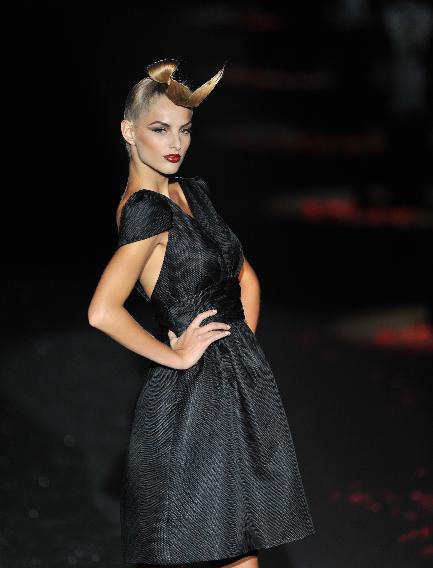
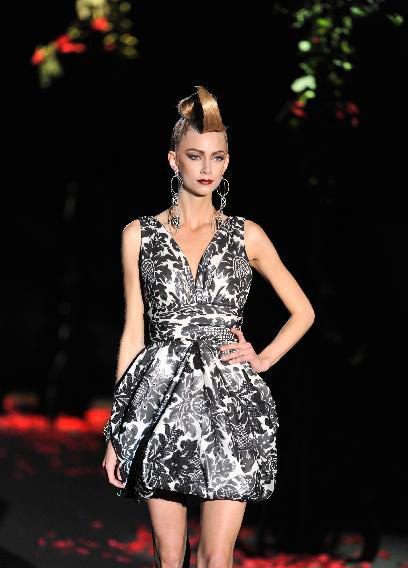
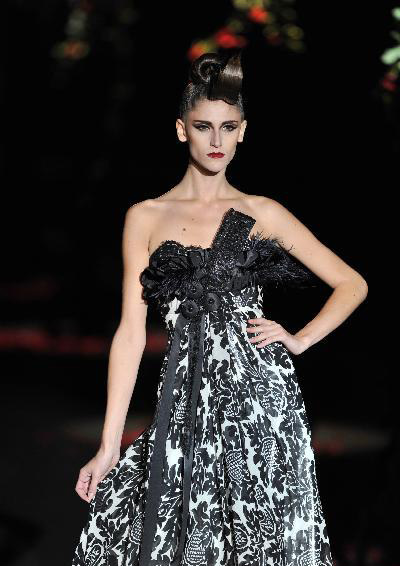
Recently, many famous fashion brands in Ningbo say no to luxurious flagship stores. Instead, mini stores with an area of 30 square meters and stores in neighborhoods are warmly welcomed. In this year, the famous suit brand Romon starts its "fast store" strategy. It aims to have 4,000 stores in 5 years.
At the same time, sub-brands under Shanshan Group open a lot of new stores in big cities. They plan to open over 200 stores with the sales revenue of over 100 million this year.
Fashion trend changes all the time and enterprises must be fast enough so as to win the market. However, traditional garment enterprises in Ningbo pay little attention to design. They cannot compete with other fast fashion brands under the fast consumption environment. When fast fashion brand representatives Zara and H&M enter China market, traditional garment enterprises face furious competition. The traditional ones have to be faster than them to get back the market.
Fast fashion rewrites old rules of garment industry. After Romon adopts "fast store" strategy, it establishes new stock disposal policy based on informationization, which makes it more competitive.
Actually, it is design that makes fashion industry "fast". Peace Bird has a strong design team with over 130 designers. It launches over 5000 new creations a year.
There are three factors preventing shoemakers in Chengdu city to expand internal market, said Cui Ting, general-secretary of Sichuan Footwear Association.
First is the internal defects in enterprises, shoemakers in Chengdu neglected the brand promotion, and reliance on low-priced competition in the markets, further more they sell their products to distributors or through wholesale markets.
Second is making the processing trade, most of shoemakers do the OEM business, retail sales and outlet controlled by foreigners, and the profits earned from processing trade are small and scant.
The third is weakness in brand creation. Although many of them have their own brands, they spent less investment on expansion of internal market and brand promotion.
How to increase the sales in internal market and creation of brand, Cui Ting suggusts that more efforts should be done to achieve such target, for instance sticking to creation of own brand, building of retail sales, and attracting more specialists in marketing.
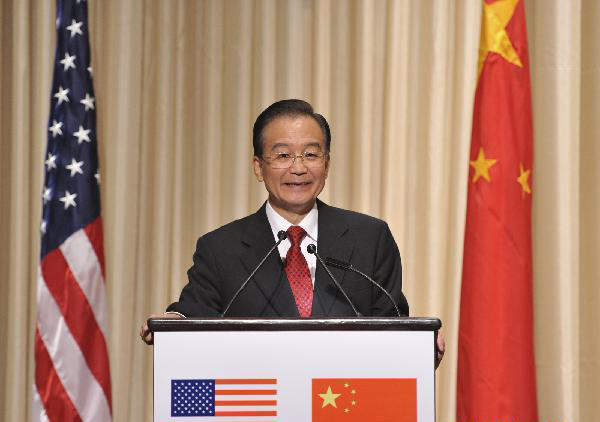
Chinese Premier Wen Jiabao gives a speech at a welcoming banquet hosted by U.S. friendly organizations in New York on Sept. 22, 2010.
Visiting Chinese Premier Wen Jiabao said here Wednesday there was no basis for the drastic appreciation of the yuan, the Chinese currency.
During a speech at a welcome banquet by U.S.-China friendship organizations, Wen said the issue of the yuan exchange rate was an economic one and must not be politicized.
Some have linked the yuan exchange rate with China's favorable balance of international trade, saying China keeps the level of the Chinese yuan low to win competitive advantages.
However, Wen said, there was no certain connection between the exchange rate and a favorable balance of trade.
For example, the United States had maintained a trade surplus for more than 90 years, from the 1870s to the 1970s. But this had become a trade deficit since then and the imbalance had grown bigger in the following years, which was obviously not caused by exchange rate fluctuations, Wen said.
China had maintained a favorable balance against the United States and the European Union, but had a trade deficit with Japan and South Korea, which indicated the trade imbalance between the two countries could not be explained by the level of the yuan exchange rate, Wen said.
He said China had always been highly responsible on the issue of the yuan exchange rate and the issue should be considered with a historical view.
According to statistics based on the exchange rate index of the Bank for International Settlements, the yuan had appreciated by a massive 55.2 percent since January 1994 as of July this year.
Meanwhile, major currencies of the world had depreciated, with the U.S. dollar dropping 2.5 percent, the euro 3.8 percent and the Japanese yen 19.5 percent.
Following the latest global financial crisis, a lot of countries' currencies witnessed drastic depreciation.
During the same period, the yuan had remained basically stable, which contributed greatly to stabilizing the international financial situation and promoting a world economic recovery, Wen said.
The yuan had seen increased flexibility since June 19, when China launched further reforms of the yuan exchange rate mechanism, he said.
Wen said China had made active efforts while still facing great difficulties and there was no basis for drastic appreciation.
Reforms on the exchange rate, which was in accordance with China's long-term and fundamental interests, would be continued, he said.
At the same time, China would also launch structural reforms in an active and effective way to expand domestic demand, particularly civilian consumption, and to promote a sustainable balance of payments, Wen said.
"Charlotte Ronson NEW YORK FASHION'S NIGHT OUT" will be helad at Roof top,The House of Roosevelt No.27 Zhongshan Dongyi Road The Bund in Shanghai on Sept27,2010 (Monday).
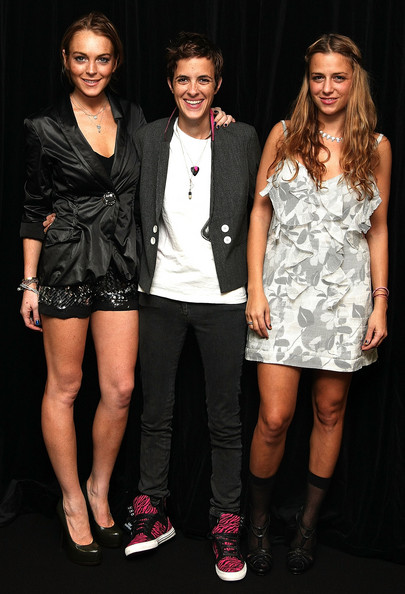
Actress Lindsay Lohan, DJ Samantha Ronson and designer Charlotte
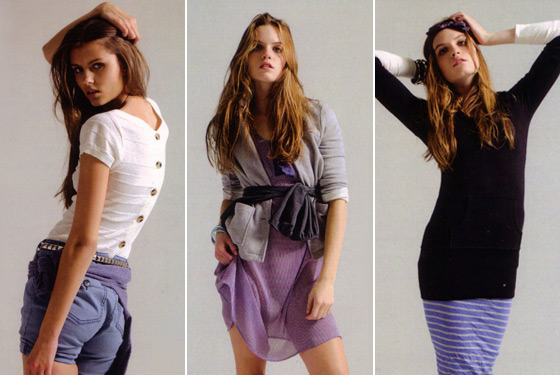
Charlotte Ronson Collection
Related information:
Charlotte Ronson Entering Chinese Market
Charlotte Ronson has formed an alliance with Hong Kong-based MH Concepts to bring the contemporary brand to China.
The partnership marks Ronson’s first Chinese venture and will begin with the fall Charlotte Ronson collection in July, when four doors open in Hong Kong, Shanghai, Beijing and Guangzhou. Six additional doors are to launch before yearend, reaching a total of 200 by 2014 throughout China, Hong Kong and Macau.
The doors include freestanding stores, mall units and department store shop-in-shops. Thirty percent will be directly operated by MHC, and the rest will be franchises. Merchandise will be sold in China online at charlotteronson.cn. The entire venture is expected to generate $10 million in first-year sales.
The deal incorporates both distribution and licensing and encompasses Ronson’s clothing, footwear, bags, accessories and small leather goods. In the first year, 50 percent of the merchandise will be produced by Charlotte Ronson International and 50 percent produced by privately held MHC, which was founded in 2007 by Meanne Ho, a former vice president of Gap Inc. Asia Pacific.
About MH Concepts Limited:
Prior to setting up MH Concepts, Meanne Ho was Vice President, Asia Sourcing, of Gap Inc which includes 6 brands: Gap, GapKids, BabyGap, GapBody, Banana Republic and Old Navy. She has in depth knowledge of the apparel industry and its operating mechanics to support USD16B+ retail revenue business. Meanne managed multi-national locations covering 20+ countries with over 800+ employees and implemented appropriate growth initiatives to support a USD3B+ sourcing volume business. Meanne developed new product lines through market research that combined science and art, formulating new business categories to support business growth. Able to recognize and capitalize on business opportunities.
In the Retailing distribution area, she opened 3000 SF ‘Show and Tell’ store in Shanghai in record time of 4 weeks from concept development > production > store opening. She is expanding the retail business by obtaining the licensee of Charlotte Ronson for Greater China Region in 2010.
With her wide scope of experience in the industry, she provides consultant service to reputable retailer for sourcing/retailing advice. She was invited by International association e.g. UK Fashion Exports (UKFE) as guest speaker for seminars in Nov 2009.
Report by nonprofit group Global Language Monitor ranks Hong Kong world's #2 fashion capital behind New York, Shanghai ranked 12.
In today's list-crazy world, Shanghai may be ranked China's most luxurious city and one of the world's top 10 in terms of retail spending, but according to the nonprofit group the Global Language Monitor, Shanghai is among the world's top fashion capitals as well. As Luxury Insider (via China Daily) points out, this year New York topped the list of global fashion capitals - reclaiming the spot from Milan - Asian powerhouses like Hong Kong (this year's #2) and Shanghai (#12) have made great strides, with Shanghai in particular surprising many by beating out Tokyo (#14) this year.
From China Daily:
"The Orient is definitely where Westerners wish to check out about fashion," said Chinese fashion critic Lin Jian.
Ji Cheng, a Shanghai-based designer who flies frequently to the world's fashion centers for shows, sees more energy in the upcoming fashion capital of Shanghai.
"You have to admit Hong Kong is a more matured fashion destination - at least 20 to 30 years more advanced than Shanghai, but there's a gap between the well-established designers like Vivian Tam who are now 53 and the new generation of Hong Kong designers," she said.
"As for Shanghai, which I see more as the gathering place for young freelancers and newcomers, a growing number of designers are making the difference," she said.
Professor Bian Xiangyang from Shanghai-based Donghua University caught a hint of economic influence on the fashion list by saying "international influence is a necessary element to make sure you're on the list".
"Because of its depressing performance from an economic perspective in recent years, Japan doesn't have the same impact it used to have. While with Expo 2010 Shanghai on the horizon, Shanghai caught up," he said.
Although Shanghai's growing prominence on this and other "world's best" lists should please many in the city's fashion industry, observers are quick to point out that the results should be taken with a grain of salt. As rankings for this year's Top Global Fashion Capitals list were compiled by tracking the frequency of words and phrases in print and electronic media, on the Internet and throughout the blogosphere rather than broader statistical analysis, some like Bao Mingxin of Donghua University, doubt the list's credibility. As Bao told China Daily, "Couch potatoes with no fashion experience could say something on the Internet nowadays."
Skepticism aside, it's hard to argue that the presence of Chinese designers on the world stage won't become more pronounced in coming years, particuaraly as they've had some pretty high-profile support in recent months from companies like Hermes - whose Shang Xia sub-brand is completely in the hands of homegrown Chinese designers - and Hong Huang's Brand New China.
According to news released from Shishi office of Fujian Inspection and Quarantine Bureau, footwear exports in the city set a record high to 112.974 million U.S. dollars in the first eight months, up 39.4% from a year earlier. Its value stands at 44.9% of the city total exports.
Due to production costs rising and revaluation of RMB, unit price for per pair of shoes rose by 12.89% to $3.24 dollars for the same period.
An official of Fujian Inspection and Quarantine Bureau expressed the satisfaction on footwear exports, and said the unite price increase is evident to the improvement on competitiveness and value-added in footwear exports, high-priced footwear exported to EU and America shows strong growth, shoe made from textile to EU grew 199.1% while exports to Middle East, Africa, ASEAN and other emerging regions remained the same or even slight decline.